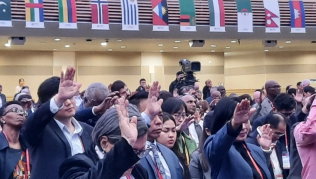COLORADO SPRINGS, Colo. – HIV/AIDS, the incurable disease affecting over 40 million people worldwide, attracted less than a dozen people at an annual gathering of some of the top Christian journalists in the nation.
“‘Black Death’…I wanted to make the title of this workshop as scary as I possibly could to try to hopefully motivate journalists to run into the burning building,” joked workshop leader Tim Morgan, deputy managing editor of Christianity Today, during one of the several workshops held Friday at the 2007 Evangelical Press Association Convention. “When everyone else is fleeing the tornado [journalists] are running toward the disaster to cover the story.
“So we can see who showed up, right?” he said with a laugh while assuring attendees that they will have a “great” workshop despite the low turnout.
Morgan, who broke into the journalism arena around the time AIDS was first widely known, made clear at the start of the session entitled “Black Death: Why the HIV/AIDS Story is Still Big” that people, in general, experience a “chronic state of compassion fatigue” towards HIV/AIDS.
As a result, journalists need to be aware of this obstacle and find alternative ways to approach the same story that will engage readers, he said.
The Christianity Today editor advised avoiding a direct approach to the disease such as the popular problem-intervention structure but instead telling the story through counterintuitive ways.
For instance, instead of portraying the HIV/AIDS disease as simply a moral or scientific problem, Morgan advocates that writers tell the HIV/AIDS story through the lens of a relational pandemic where real-life people are left utterly devastated from losing mothers and fathers, husbands and wives.
“It is a relational pandemic; it spreads through relational networks,” emphasized Morgan. “So we need to understand that there is a relational component to this pandemic…. We have to have a relational strategy both as a church and as a journalist – that’s what it is going to take.”
Acquired Immune Deficiency Syndrome (AIDS) is an infectious disease that spreads through direct contact of a mucous membrane or the bloodstream with a bodily fluid containing HIV. Victims of the disease exhibit a range of symptoms resulting from damage to the immune system caused by the human immunodeficiency virus (HIV). Currently, although there are treatments for HIV and AIDS to slow the progression of the disease, there is no known cure.
In 2006 alone, there are 4.3 million people newly infected with HIV and 2.9 million people dead, according to the Joint United Nations Programme on HIV/AIDS (UNAIDS).
One of the attendees shared her struggle with raising awareness on the deadly disease of people only wanting to read “warm-fuzzy” stories of the situation getting better when in actuality things are in some sense getting worse with 13,000 new infections daily.
“Our human nature is we want off-the-hook,” responded Morgan, “but God isn’t going to let us off-the-hook.”
Morgan, who has made HIV/AIDS one of the “Big 5” issues in his life and career, concluded with an analogy between the Holy Grail and AIDS.
“It is like the Holy Grail development – it’s a sustainable development,” he said. “The fascinating thing is the Gospel is all about sustainable development. If you look into the heart of the Gospel it is sustainable innovation – Jesus Christ died for you and He wants you to have a new life.”
Tim Morgan, who brings 26 years of journalism experience to award-winning Christianity Today magazine, was among some of the top professionals in the evangelical media field who shared their knowledge with colleagues at the annual Evangelical Press Association Convention held this year in Colorado Springs, Colo. The convention annually convenes hundreds of evangelical journalists, editors, designers and executives to share skills and develop networks in the industry.







